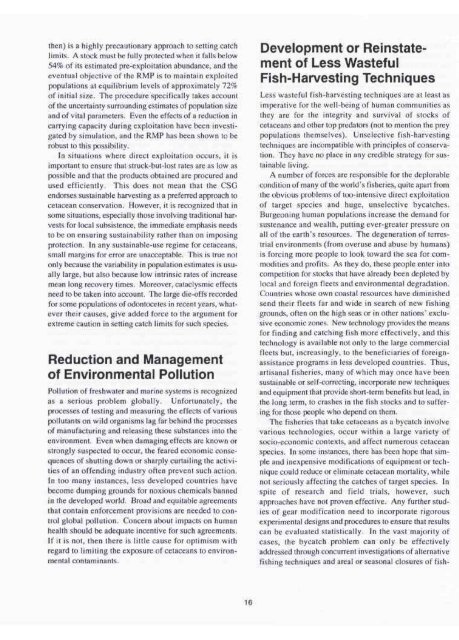Dolphins, Porpoises, and Whales - IUCN
Dolphins, Porpoises, and Whales - IUCN
Dolphins, Porpoises, and Whales - IUCN
Create successful ePaper yourself
Turn your PDF publications into a flip-book with our unique Google optimized e-Paper software.
then) is a highly precautionary approach to setting catch<br />
limits. A stock must be fully protected when it falls below<br />
54% of its estimated pre-exploitation abundance, <strong>and</strong> the<br />
eventual objective of the RMP is to maintain exploited<br />
populations at equilibrium levels of approximately 72%<br />
of initial size. The procedure specifically takes account<br />
of the uncertainty surrounding estimates of pxjpulation size<br />
<strong>and</strong> of vital parameters. Even the effects of a reduction in<br />
carrying capacity during exploitation have been investigated<br />
by simulation, <strong>and</strong> the RMP has been shown to be<br />
robust to this pxjssibility.<br />
In situations where direct exploitation occurs, it is<br />
important to ensure that struck-but-lost rates are as low as<br />
possible <strong>and</strong> that the products obtained are procured <strong>and</strong><br />
used efficiently. This does not mean that the CSG<br />
endorses sustainable harvesting as a preferred approach to<br />
cetacean conservation. However, it is recognized that in<br />
some situations, especially those involving traditional harvests<br />
for local subsistence, the immediate emphasis needs<br />
to be on ensuring sustainability rather than on imposing<br />
protection. In any sustainable-use regime for cetaceans,<br />
small margins for error are unacceptable. This is true not<br />
only because the variability in population estimates is usually<br />
large, but also because low intrinsic rates of increase<br />
mean long recovery times. Moreover, cataclysmic effects<br />
need to be taken into account. The large die-offs recorded<br />
for some populations of odontocetes in recent years, whatever<br />
their causes, give added force to the argument for<br />
extreme caution in setting catch limits for such species.<br />
Reduction <strong>and</strong> Management<br />
of Environmental Pollution<br />
Pollution of freshwater <strong>and</strong> marine systems is recognized<br />
as a serious problem globally. Unfortunately, the<br />
processes of testing <strong>and</strong> measuring the effects of various<br />
pollutants on wild organisms lag far behind the processes<br />
of manufacturing <strong>and</strong> releasing these substances into the<br />
environment. Even when damaging effects are known or<br />
strongly suspected to occur, the feared economic consequences<br />
of shutting down or sharply curtailing the activities<br />
of an offending industry often prevent such action.<br />
In too many instances, less developed countries have<br />
become dumping grounds for noxious chemicals banned<br />
in the developed world. Broad <strong>and</strong> equitable agreements<br />
that contain enforcement provisions are needed to control<br />
global pollution. Concern about impacts on human<br />
health should be adequate incentive for such agreements.<br />
If it is not, then there is little cause for optimism with<br />
regard to limiting the exposure of cetaceans to environmental<br />
contaminants.<br />
16<br />
Development or Reinstatement<br />
of Less Wasteful<br />
Fish-Harvesting Techniques<br />
Less wasteful fish-harvesting techniques are at least as<br />
imperative for the well-being of human communities as<br />
they are for the integrity <strong>and</strong> survival of stocks of<br />
cetaceans <strong>and</strong> other top predators (not to mention the prey<br />
populations themselves). Unselective fish-harvesting<br />
techniques are incompatible with principles of conservation.<br />
They have no place in any credible strategy for sustainable<br />
living.<br />
A number of forces are responsible for the deplorable<br />
condition of many of the world's fisheries, quite apart from<br />
the obvious problems of too-intensive direct exploitation<br />
of target species <strong>and</strong> huge, unselective bycatches.<br />
Burgeoning human populations increase the dem<strong>and</strong> for<br />
sustenance <strong>and</strong> wealth, putting ever-greater pressure on<br />
all of the earth's resources. The degeneration of terrestrial<br />
environments (from overuse <strong>and</strong> abuse by humans)<br />
is forcing more people to look toward the sea for commodities<br />
<strong>and</strong> profits. As they do, these people enter into<br />
competition for stocks that have already been depleted by<br />
local <strong>and</strong> foreign fleets <strong>and</strong> environmental degradation.<br />
Countries whose own coastal resources have diminished<br />
send their fleets far <strong>and</strong> wide in search of new fishing<br />
grounds, often on the high seas or in other nations' exclusive<br />
economic zones. New technology provides the means<br />
for finding <strong>and</strong> catching fish more effectively, <strong>and</strong> this<br />
technology is available not only to the large commercial<br />
fleets but, increasingly, to the beneficiaries of foreignassistance<br />
programs in less developed countries. Thus,<br />
artisanal fisheries, many of which may once have been<br />
sustainable or self-correcting, incorporate new techniques<br />
<strong>and</strong> equipment that provide short-term benefits but lead, in<br />
the long term, to crashes in the fish stocks <strong>and</strong> to suffering<br />
for those people who depend on them.<br />
The fisheries that take cetaceans as a bycatch involve<br />
various technologies, occur within a large variety of<br />
socio-economic contexts, <strong>and</strong> affect numerous cetacean<br />
species. In some instances, there has been hope that simple<br />
<strong>and</strong> inexpensive modifications of equipment or technique<br />
could reduce or eliminate cetacean mortality, while<br />
not seriously affecting the catches of target species. In<br />
spite of research <strong>and</strong> field trials, however, such<br />
approaches have not proven effective. Any further studies<br />
of gear modification need to incorporate rigorous<br />
experimental designs <strong>and</strong> procedures to ensure that results<br />
can be evaluated statistically. In the vast majority of<br />
cases, the bycatch problem can only be effectively<br />
addressed through concurrent investigations of alternative<br />
fishing techniques <strong>and</strong> areal or seasonal closures of fish-

















